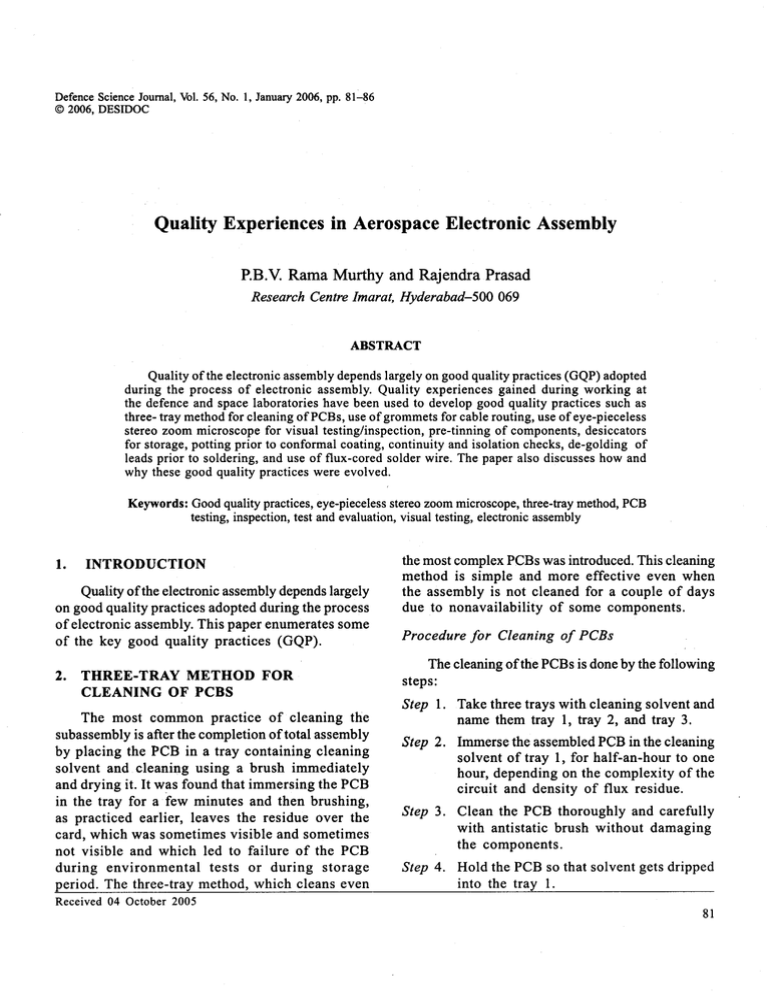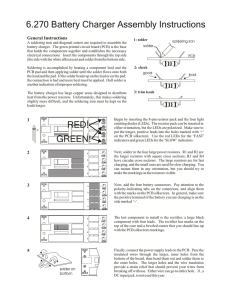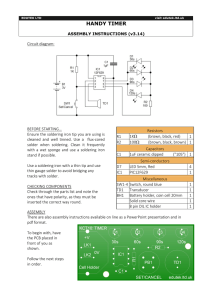Quality Experiences in Aerospace Electronic Assembly
advertisement

Defence Science Journal, Vol. 56, No. 1, January 2006, pp. 81-86 O 2006, DESIDOC Quality Experiences in Aerospace Electronic Assembly P.B.V. Rama Murthy and Rajendra Prasad Research Centre Imarat, Hyderabad-500 069 ABSTRACT Quality of the electronic assembly depends largely on good quality practices (GQP) adopted during the process of electronic assembly. Quality experiences gained during working at the defence and space laboratories have been used to develop good quality practices such as three- tray method for cleaning of PCBs, use of grommets for cable routing, use of eye-pieceless stereo zoom microscope for visual testinglinspection, pre-tinning of components, desiccators for storage, potting prior to conformal coating, continuity and isolation checks, de-golding of leads prior to soldering, and use of flux-cored solder wire. The paper also discusses how and why these good quality practices were evolved. Keywords: Good quality practices, eye-pieceless stereo zoom microscope, three-tray method, PCB testing, inspection, test and evaluation, visual testing, electronic assembly 1. INTRODUCTION Quality of the electronic assembly depends largely on good quality practices adopted during the process of electronic assembly. This paper enumerates some of the key good quality practices (GQP). 2. THREE-TRAY METHOD FOR CLEANING OF PCBs The most common practice of cleaning the subassembly is after the completion of total assembly by placing the PCB in a tray containing cleaning solvent and cleaning using a brush immediately and drying . - it. It was found that immersing the PCB in the tray for a few minutes and then brushing, as practiced earlier, leaves the residue over the card, which was sometimes visible and sometimes not visible and which led to failure of the PCB during environmental tests or during storage period. The three-tray method, which cleans even the most complex PCBs was introduced. This cleaning method is simple and more effective even when the assembly is not cleaned for a couple of days due to nonavailability of some components. Procedure for Cleaning of PCBs The cleaning of the PCBs is done by the following steps: Step 1. Take three trays with cleaning solvent and name them tray 1, tray 2, and tray 3. Step 2 . Immerse the assembled PCB in the cleaning solvent of tray 1, for half-an-hour to one hour, depending on the complexity of the circuit and density of flux residue. Step 3. Clean the PCB thoroughly and carefully with antistatic brush without damaging the components. Step 4 . Hold the PCB so that solvent gets dripped into the tray 1. Received 04 October 2005 81 DEF SCI J, VOL. 56, NO. 1, JANUARY 2006 Step 5 . Immerse the PCB in the tray 2 and follow the steps 2 to 4 . Step 7 . Dry the PCB in hot air. So, the usage of eye-pieceless microscope in defence laboratories was popularised for visual testing1 inspection. These eye-pieceless microscopes, besides having all the facilities which a normal microscope has, also give strain-free view and permit the usage of eye glasses in addition. 3. USE OF GROMMETS FOR CABLE ROUTING 5. PRE-TINNING OF COMPONENTS It was observed that the wire bunch in the electronic enclosures or in the electromechanical assemblies from one compartmentlcabin to the other, which was normally routed through the cut partition or through a hole, was not protected from abrasions of metallic portions due to rubbing of wires against sharp portions of hole edges, leading to cuts in the wire insulation, and ultimately shorting the wires to chassis (Fig. 1 ) . To avoid the wire abrasions, insertion of grommets inside the holes through which wires were to be routed, was implemented (Fig. 2). This has avoided 100 per cent failures of wire cuts. It was observed that the majority of vendors were soldering the components directly to the PCB without improving the solderability of the leads to be soldered, resulting in defective joints like improper1 poor wetting, dry joint, etc, and subsequently leading to total failure in the form of breakage of the contact. After the introduction of tinning of leads prior to soldering, defect level of the joints was reduced to 1 per cent or even less. Pre-tinning removes tarnish of the leads and improves solderability and also avoids untwisting and separation of strands for wires. The solder material used for the tinning is Sn60. So, as a good quality practice, it was recommended that the solder bath should be checked periodically for the solder composition. Step 6 . Immerse the PCB in the tray 3 and follow the steps 2 to 4 . 4. EYE-PIECELESS STEREO ZOOM MICROSCOPE FOR VISUAL TESTING1 INSPECTION The stereo zoom microscope used in the visual testinglinspection gives strain to eyes on continuous usage, and also does not allow usage of eye glasses. Figure 1. Insulation rupture against metallic hole edge Procedure for Pre-tinning of Components Following steps are involved in the pre-tinning of the components: Figure 2. Insulation protection due to grommet RAMA MURTHY & RAJENDRA PRASAD: QUALITY EXPERIENCES IN AEROSPACE ELECTRONIC ASSEMBLY Step 1 . Straighten the leads, if required. Step 2. Clean the lead using the typewriter eraser up to 2d from the body, where d is the diameter of the lead. Step 3. Apply flux. Step 4 . Drip out excessive flux using blotting paper. Step 5 . Dip the leads in the solder bath using antiwicking tool up to 2d from the body, where d is the diameter of the lead. Step 6 . Clean the leads thoroughly. Step 7 . Inspect for solderability- the solder should cover 95 per cent of the lead area. 6. CONTINUITY & ISOLATION CHECKS It is a normal practice for all the designers to check immediately the electrical function of the circuit for any malfunctioning after completion of wiring and getting into debugging of the circuit and PCB wiring. The circuits also fail in the environmental testing if insulation is not proper, which make difficult to find the problem. Majority of the circuits fail due to improper wiringlimproper cleaninglimproper isolation. cable specification and the resistance should be >200 MQ. 7. DESICCATORS FOR STORAGE Desiccators have been in use at the places near the seashores due to high humidity throughout the year. At all other places, the use of desiccators for storage was avoided as the humidity levels were low most of the time of the year. It was observed that humidity plays an important role in the storage of the componentslassembled PCBs. It was a common practice that the process of the assembly of PCBs was extended to night under airconditioned environment without proper humidity control. Due to extension of working time over to night, assemblies/components experience room temprature always at lower side. The condensation of the water in the form of molecules occur over the assemblieslcomponents. This moisture trapped inside leads to formation of corrosion in the form of tarnish, and if left untouched over a long period, whiskers are formed. So, the desiccation for storage was adopted as a good storage practice. Figure 3 shows the corrosion of the leads in the form of surface tarnish and Fig. 4 shows the whisker formation on the surface of gold plated connector lead stored for a long period. To avoidJreducethe failures due to these. contiriuitv cable assemblies, the voltage should be twice the Figure 3. Tarnish formation (Magnification 200 X) 83 DEF SCI J, VOL. 56, NO. 1, JANUARY 2006 Hence, it was recommended that the potting should be done prior to application of conformal coating and should bridge the component body and the PCB surface, and should not interfere with the stress relief (lead bend) provided for the components leads. Figure 5 shows the damage of a lead in the form of deformation observed after vibration as the vendor had done the potting prior to conformal coating and potting aided the damage instead of protecting it. Figure 6 shows breakage of edge leads for a multi-leaded component observed after vibration. 9. GROUP A Rr GROUP B TESTING OF PCBs It was observed that some of the vendors were potting the components, that were sensitive to vibration1 heavier components, after the completion of conformal coating of the cards. As the conformal coating has very smooth surface, the potting over the conformal coating does not have any grip and acts like a lump mass and damages the component instead of giving protection to the component under coating. There are two types of PCBs, commercial grade and the military grade. In a commercial grade PCB, inspection/checks are not carried out and is used as it is. Aerospace requires highly reliable PCBs that work throughout the life span without any failure. The quality of a military grade PCB starts from the basic raw material, and subsequent process of manufacturing the PCB. It is very difficult to do the third-party verification. The MIL standard introduced inspection of the final product, including its qualification. As per the recommendation, PCB should be purchased from a MIL (QPLIQML) qualified manufacturer only. The manufacturer was made responsible for completion of all in-process inspections and group A inspections of the PCBs. It was mendatory Figure 5. Lead deformation Figure 6. Lead breakage Figure 4. Whisker formation (Magnification 200 X) 8. POTTING OF COMPONENTS PRIOR TO CONFORMAL COATING 84 RAMA MURTHY & RAJENDRA PRASAD: QUALITY EXPERIENCES IN AEROSPACE ELECTRONIC ASSEMBLY that the group B testing should be carried out by the approved third-party agency only. After the introduction of group A i d group B testing requirement, quality of the PCB improved to such a level that no failure was found due to PCB's. 10. DE-GOLDING OF LEADS PRIOR TO SOLDERING When a tidead-plated component lead is soldered, an intermetalic compound is formed between the component lead and the PCB, which comprise tin/ lead and copper, and which acts like a bond. If a gold-plated lead is soldered, a goldkin intermetalic compound is formed which is brittle in nature and such a joint will be very dull near to the PCB surface. This embrittlement of the solder fillet causes the joint to fail subsequently during the environmental tests or during storage. As a good quality practice, it was recorrimended that the solder bath should be checked periodically for the solder composition as bath could be contaminated by gold. It was found that by the removal of gold from the solder bath, considerable reduction in the solder joint defects was achieved. In this process, two baths are used, one for de-golding and the other for normal tinning. Procedure for De-golding of Leads The following steps are involved in the de-golding of leads: Step 1. Straighten the leads, if required. Step 2 . Clean the lead. Step 3. Apply flux and drip out excessive flux. Step 4 . Dip the leads in the same way as in tinning in the solder bath kept for de-golding. Step 5 . Do the tinning as per the standard procedure. 11. USE OF FLUX-CORED SOLDER WIRE It was observed that as a general practice, people used solid wire for soldering with liquid fluxlsolid flux. As a good quality practice, the usage of solid flux was totally eliminated and it was made mandatory to use liquid flux. The usage of solder wire with flux-cored one was also introduced. After application of liquid flux on the pad-lead intersection to be soldered, soldering iron was applied by the operator to bridge the pad and the lead, as all the flux is evaporated after doing its intended function. From the time of applying solder to the completion of soldering, there is no need of any protection from the environment, which is taken care of by the flux vapours. Flux embedded in the flux-cored wire acts at this point and makes the joint defect-free. In the flux-cored wires, there are single-cored, three-cored, and five-cored solder wires. It is preferable to use five-cored solder wire to get better solder spreading. 12. CONCLUSION Quality of the electronic assembly depends largely on good quality practices adopted during the process of electronic assembly. Experiences of authors while working at the defence and space laboratories have helped enormously in improving quality of electronic assemblies and the workmanship failures. Wherever these good quality practices have been adopted strictly, the electronic assemblies failures have come down to almost zero. It is recommended, that wherever electronic assemblies are involved, these good quality practices should form a part of the quality system. DEF SCI J, VOL. 56, NO. 1, JANUARY 2006 Contributors Mr P.B.V. Rama Murthy had more than 20 years of experience in the quality control at Indian Space Research Organisation (ISRO) and Defence Research & Development Organisation (DRDO). At VSSCIISRO, Thiruvananthapuram, he is responsible for clearance of all avionics packages for flight. He independently handled the hundreds of flight packages for ASLV, PSLV, and GSLV. He is having teaching experience in the area of high reliable interconnection assembly techniques, PCB design and packaging and used to teach in VSSC soldering school. He is also responsible for vendor qualification in the area of PCB (multilayer and metal core) manufacturing and electronic assembly. Presently, he is working as Scientist D in the Directorate of R&QA at the Research Centre Imarat (RCI), Hyderabad, and is the System Manager (QA) for AD mission and is responsible for clearance of flight hardware and system integration. He is also System Manager for gyros and INS systems being developed by RCI, Hyderabad.

